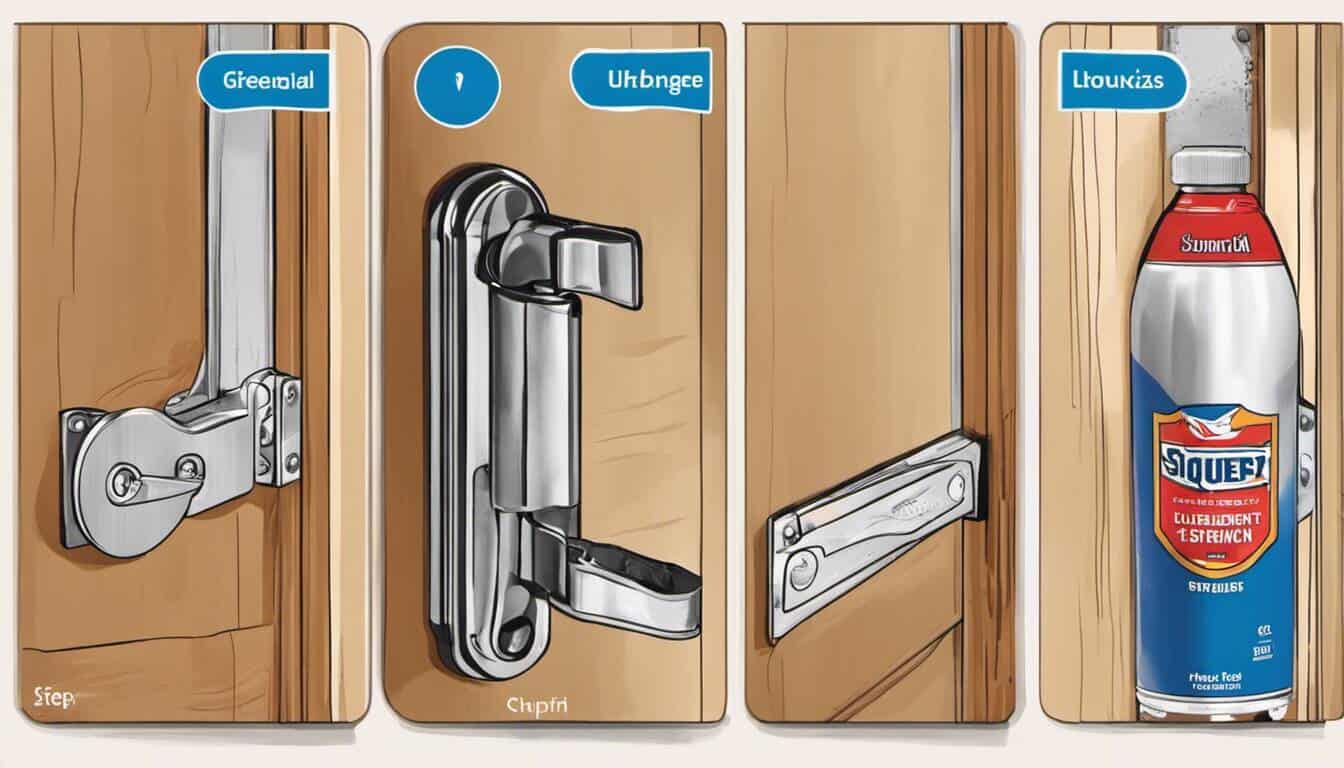Here’s how I dealt with squeaky doors in my home: Imagine enjoying a peaceful moment, only to be bothered by the sound of a squeaky door. It’s annoying, and quite honestly stressful, but I found a simple fix. Using items I already had, I silenced the squeaks and restored peace. Check out my DIY guide on fixing this issue to save yourself time and money, and to showcase your own handy skills!
There are several methods to fix squeaky doors, including tightening loose screws, lubricating the hinges with a dry graphite or non-water-based lubricant like white lithium or 3 in 1 oil, or taking stress off of one hinge at a time by removing the hinge pin and tapping it back in slightly loose. If these methods aren’t successful, there may be an alignment issue with the hinge barrels that requires further examination. For a comprehensive guide on these fixes, check out my 1-hour home fix tutorial.
“”Regular maintenance is the key to sustain silent doors around your home. Use a damp cloth to clean the hinges and apply sewing machine oil or a silicone spray regularly. These minor tweaks will elongate the lifespan of your doors and make your home a tranquility of peace. For a comprehensive weekly home checklist that includes door maintenance, visit our website.”
Thaddeus Kendrick, Professional Carpenter
Identifying Squeaky Door Causes
A squeaky door can be quite an annoyance, disrupting the peace and tranquility of your home. But before you delve into fixing it, it’s important to identify the root cause of the squeak. There are a few common culprits that could be at play.
Firstly, hinges are a common source of squeaks. Over time, these metal components can become misaligned due to various factors such as frequent use, age, or improper installation. Another potential cause is material degradation, where the door itself or its frame may have worn down or suffered damage over time.
But how do you determine which of these issues is causing your squeaky door? One way is to observe when the sound occurs. If the squeak happens when you open or close the door, it’s likely related to hinge misalignment. On the other hand, if the noise is more constant or intensifies when pressure is applied to the door, it could be indicative of material degradation.
For instance, if your house was built in the 1940s and underwent extensive renovations but still has persistent squeaky doors in certain rooms, it could be attributed to hinge misalignment due to improper installation during the renovation process.
Now that we’ve identified some of the causes of a squeaky door, let’s dive deeper into one key factor: understanding door hinge misalignments.
Understanding Door Hinge Misalignments
Hinges play a vital role in ensuring smooth door operation. When hinges become misaligned, they can lead to unwanted friction and subsequently cause that irksome squeaking sound. The most common reason for hinge misalignment is a lack of proper barrel alignment between the door and the jamb or between hinges themselves.
To rectify this issue, one approach is to take stress off each hinge individually. This can be done by removing the hinge pin and tapping it back in slightly loose. This alleviates the pressure on the hinge, reducing the friction that causes squeaking. It’s important to move one hinge at a time to avoid throwing the door out of alignment.
Another effective method is to utilize dry graphite lubricant. Apply it to the side of the hinge and down into the hole where the pin goes. Additionally, lubricate the hinge pin itself and drive it back in while moving it back and forth. This ensures proper distribution of the lubricant and helps minimize friction.
For those who prefer an alternative lubricant, pencil scribbling or graphite powder can be used as well. While these options may be slightly messier, they provide long-lasting lubrication results.
However, if lubrication doesn’t completely solve the problem, there may be an underlying issue with hinge barrel alignment. In such cases, a more involved solution might be required, such as removing certain hinge pins and carefully banging them back in place to align them correctly.
By understanding the misalignment issues that can occur with door hinges and employing suitable lubrication methods, you can effectively address squeaky door problems and restore peace and quiet to your home.
Recognizing Signs of Material Degradation
Before we delve into the techniques to fix squeaky doors, it’s important to recognize the signs of material degradation that might be causing the annoying noise. Squeaky doors can be a result of various factors, such as misalignment between the door and the jamb or between hinges. In older houses, like those built in the 1940s, these issues can become more prevalent due to wear and tear over time. Examine your door hinges closely and look for any visible signs of rust, corrosion, or damage. If you notice any of these indicators, it’s likely that the hinge barrels are not aligned correctly, which can lead to squeaking.
Now that we have identified the signs of material degradation that can contribute to squeaky doors, let’s move on to exploring some effective techniques to fix this common household nuisance.
- To effectively fix squeaky doors, it is essential to identify the signs of material degradation that cause the noise. Factors like misalignment between the door and jamb or hinges in older houses can lead to wear and tear over time, leading to squeaking. Examining your door hinges for rust, corrosion or damage is crucial as these issues indicate incorrect hinge barrel alignment, which can result in squeaking.
Techniques to Fix Squeaky Doors
Fixing squeaky doors can be done through various techniques depending on the root cause of the problem. One commonly utilized method is lubrication. Lubricants such as white lithium, liquid graphite, 3 in 1 oil, or even pencil scribbling/graphite powder can be used to reduce friction between the door hinge components and alleviate the squeaking sound. It’s important to use a non-water-based lubricant to prevent quick drying and recurring squeaking. For a list of essential tools and lubricants for this job, check out my toolbox essentials guide sound. It’s important to use a non-water-based lubricant to prevent quick drying and recurring squeaking.
For instance, applying a few drops of 3 in 1 oil onto the hinge components is often sufficient to silence a squeaky door. The oil penetrates into the tight spaces within the hinge mechanism, reducing friction and eliminating noise. Similarly, graphite powder or pencil scribbling on the hinge knuckles can provide long-lasting results.
If lubrication doesn’t solve the issue, it may be necessary to address alignment problems between the door and the jamb or hinges. This could involve removing hinge pins and tapping them back in slightly loose, allowing stress to be taken off the hinges. In some cases, hinge pins may need to be removed and carefully banged back in place to realign them correctly.
Whether you choose to lubricate or adjust the alignment of your squeaky doors, it’s important to approach each technique with care and precision. Now that we have explored these techniques in detail, you’ll be better equipped to bring peace and quiet back into your home.
Utilising Lubricants for Hinge Noise Reduction
If you’ve ever been woken up by the annoying sound of a squeaky door in the early morning, you understand the importance of finding a solution to reduce that noise. One effective method is to utilize lubricants for hinge noise reduction. There are various options available that can help silence those squeaks and restore peace to your home.
White lithium grease is commonly used to lubricate squeaky door hinges. It provides a smooth and long-lasting lubrication that can significantly reduce noise. However, some people find that it only lasts a few weeks before the squeaking returns.
Another option is using liquid graphite, which can be messy but offers long-lasting results once applied. A couple drops of 3 in 1 oil can also do wonders in lubricating squeaky doors and ensure quiet operation. Additionally, pencil scribbling or graphite powder can be used to coat the hinges, although it may be messier than other options.
It’s essential to note that when applying lubricants, it’s best to focus on the side of the hinge and down into the hole where the pin goes. The hinge pin should also be lubricated before being driven back in while moving it back and forth. Using a non-water-based lube is recommended to prevent quick drying and recurring squeaking.
Adjusting Hinge Alignment to Prevent Squeaking
Sometimes, even with proper lubrication, the problem may persist if there’s an alignment issue with the hinge barrels. In such cases, adjusting hinge alignment can play a crucial role in preventing squeaking. This step involves taking stress off one hinge at a time by removing the hinge pin and tapping it back in slightly loose.
For example, in an old house built in the 1940s with extensive renovations done over time, the barrel alignments of the hinges might not be right. In this scenario, some of the hinge pins may need to be removed and gently banged back in place to align them correctly. It’s important to be cautious when doing this to avoid bending cheap hinges by applying excessive force or dropping them on the floor. Using the right drill bit can make this process much easier and more precise.
By ensuring proper alignment between the door and the jamb or between hinges, you can minimize friction and eliminate squeaking noises. This adjustment might require some trial and error, as it’s crucial to find the perfect balance where the door swings smoothly without any unnecessary noise.
Remember that fixing squeaky doors is a gradual process, but the effort is worth it for a peaceful and serene home environment. Combining lubrication with proper hinge alignment can provide long-lasting solutions to keep those annoying squeaks at bay.
Long-Term Solutions for Quieter Doors
When it comes to addressing the issue of squeaky doors, it’s important to seek long-term solutions that will provide lasting relief. While temporary fixes like lubrication can temporarily alleviate the noise, a more comprehensive approach is needed for a truly quiet home. One effective long-term solution is to assess and adjust the alignment of the door and hinges. Misalignment between the door and jamb or between hinges can cause excessive friction and lead to squeaking. By taking steps to realign these components, you can significantly reduce or even eliminate the annoying squeaks for good.
Another option to consider is upgrading your hinges. If you’re dealing with cheap or low-quality hinges, they may be prone to bending or warping over time, which can contribute to squeaking. Investing in sturdy and well-made hinges can provide added durability and stability, reducing the likelihood of squeaks in the future.
Additionally, reinforcing and strengthening the door frame can help minimize movement and prevent future squeaking. Address any loose or weak areas by tightening screws, adding additional screws or using wood shims to provide extra support. By ensuring that your door frame is secure and stable, you can prevent unnecessary rubbing between the door and frame that leads to noise.
Now that we’ve explored some long-term solutions for quieter doors let’s turn our attention to maintaining door health through preventative measures.
Maintaining door Health: Preventative Measures
Prevention is often easier than dealing with problems after they arise. By taking proactive measures, you can maintain your doors’ health and prevent potential issues like squeaking from occurring in the first place. Regular maintenance plays a vital role in prolonging the lifespan of your doors and keeping them in optimal condition.
One key preventative measure is regular cleaning and lubrication of hinges. Over time, dust, debris, and grime can accumulate within the hinge mechanism, causing friction and leading to squeaks. By cleaning the hinges periodically with a soft brush or cloth, removing any build-up, and applying a suitable lubricant recommended for door hinges, you can keep them operating smoothly and quietly.
In addition to hinge maintenance, it’s important to inspect the door and its components regularly for any signs of wear or damage. Check for loose screws, rusted parts, or warped sections that may contribute to squeaks. Addressing these issues promptly can prevent them from escalating into more significant problems down the line.
For example, if you notice a loose screw causing the hinge to move slightly every time the door is opened or closed, tightening it immediately can help maintain proper alignment and prevent squeaking.
Ultimately, proactive care and regular inspections are essential in maintaining your doors’ health and preventing potential noise issues. By being attentive to their condition and taking prompt action when necessary, you can enjoy a quiet home without the annoyance of squeaky doors.






I had this very issue with my kitchen door last winter. In my case, a bit of WD-40 did nothing to stop the squeak. However, when I took the hinge apart, I realized there was a slight deformity causing friction. A quick replacement part from the local hardware store solved the issue – so sometimes it’s more than just about lubrication.
Thibault, I absolutely agree with you; sometimes, a bit of hardware adjustment goes a long way. Like last fall when my front door would hoot like an owl, lubrication didn’t do much until I replaced a warped hinge and voila, silence was restored!
In my many years of experience with squeaky doors, especially in cold climate, a good old graphite lubricant did the trick far better than any fancy product out there.
While also recognizing the efficacy of graphite lubricant in some cases Sergey Onegin, give silicone-based lubricants a try. I’ve found them to be particularly effective on doors that receive heavy daily use. Plus, they’re great at resisting dust collection too, ensuring a longer lasting solution. Just ensure you choose one that doesn’t stain to maintain the aesthetics of your door.
Silicone-based lubricants indeed prove useful Petrichor, but don’t discard the idea of using paraffin wax; it works wonders, especially on antique doors, reducing friction without staining the wood.